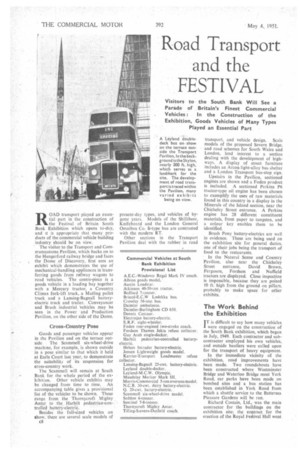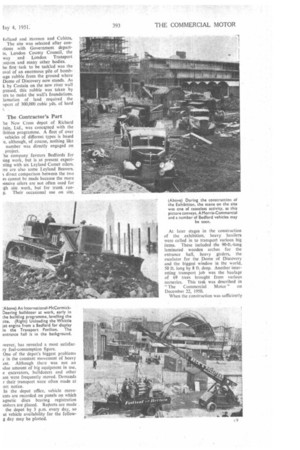Road Transport and the FESTIVAL
Page 46

Page 47

Page 48

If you've noticed an error in this article please click here to report it so we can fix it.
Visitors to the South Bank Will See a Parade of Britain's Finest Commercial Vehicles : In the Construction of the Exhibition, Goods Vehicles of Many Types Played an Essential Part
ROAD transport played an essential • part in the construction of the Festival of Britain South Bank Exhibition which opens to-day, and it is appropriate that many products of the commercial vehicle building industry should be on view.
' The visitor to the Transport and Communications Pavilion, which backs on to the Hungerford railway bridge and faces the Dome of Discovery, first sees an exhibit which demonstrates the use of mechanical-handling appliances in transferring goods from railway wagons to road vehicles. The centre-piece is a goods vehicle in a loading bay together with a Mercury tractor, a Coventry Climax fork-lift truck, a Matting pallet truck and a Lansing-Bagnall batteryelectric truck and trailer. Conveyancer and Brush industrial 'vehicles may be seen in the Power and Production Pavilion, on the other side of the Dome.
Cross-Country Pose
Goods and passenger vehicles appear in the Pavilion and on the terrace outside The Somme!l six-wheel-drive machine, for example, is shown outside in a pose similar to that which it held at Earls Court last year, to demonstrate the suitability of its suspension for cross-country work.
The Scammell will remain at South Bank for the whole period of the ex hibition. Other vehicle exhibits may be changed from time to time. An accompanying table gives a provisional list of the vehicles to be Shown. These range from the Thornycroft Mighty Antar to the Harbilt pedestrian-controlled battery-electric.
Besides the full-sized vehicles on show, there are several scale models of c8
present-day types, and vehicles of bygone years. Models of the Shillibeer, Knifeboard and the London General Omnibus Co. B-type bus are contrasted with the modern RT.
Other sections in the Transport Pavilion deal with the rubber in road transport, and vehicle design. Scale models of the proposed Severn Bridge, and road schemes for South Wales and London. lend interest to a section dealing with the development of highways. A display of street furniture includes an Arcon-light-alloy bus shelter and a London Transport bus-stop sign. Upstairs in the Pavilion, sectioned engines are shown and a Foden product is included. A sectioned Perkins P6 tractor-type oil engine has been chosen to exemplify the uses of raw materials found in this country in a display in the Minerals of the Island section, near the Chicheley Street entrance. A Perkins engine has 28 different constituent materials, frorri paper to tungsten, and a colour key enables them to be identified.
Brush Pony battery-electrics are well in evidence. These are being used on the exhibition site for general duties, one of their jobs being the transport of food to the restaurants.
In the Natural Scene and Country Pavilion, also near the Chicheley Street entrance, David Brown, Ferguson, Fordson and Nuffield tractors are displayed. Close inspection is impossible, because they are poised 10 ft. high from the ground on pillars. probably to make space for other exhibits.
The Work Behind the Exhibition IT is difficult to say how many vehicles I were engaged on the construction of the South Bank exhibition, which began in July, 1949. Each contractor and subcontractor employed his own vehicles, and outside hauliers were called upon for the transport of heavy equipment.
In the immediate vicinity of the exhibition, road improvements have been made. Two roundabouts have been constructed where Westminster Bridge and Waterloo Bridge meet York Road, car parks have been made on bombed sites and a bus station has been established in York Road from which a shuttle service to the Battersea Pleasure Gardens will he run.
Richard Costain, Ltd., was the main contractor for the buildings on the exhibition site; thc contract for the erection of the Royal Festival Hall went
I &land and liannen and Cubitts, The site was selected after conitions with Government departts, London County Council, the way and London Transport :utives and many other bodies.
he first task to be tackled was the oval of an enormous pile of bombage rubble from the ground where Dome of Discovery now stands. As k by Costain on the new river wall gessed, this rubble was taken by ers to make the wall's foundations. lamation of land required the sport of 300,000 cubic yds. of hard
The Contractor's Part
be New Cross depot of Richard tam, Ltd., was concerned with the ibition programme. A fleet of over vehicles of different types is based although, of course, nothing like number was directly engaged on project.
le company favours Bedfords for iing work, but is at present experiiting with six Leyland Comet oilers. ;re are also some Leyland Beavers. direct comparison between the two es cannot be made because the more oensive oilers are not often used for th site work, but for trunk rung. Their occasional use on site,
■ wever, has revealed a most satisfacry fuel-consumption figure.
One of the depot's biggest problems in the constant movement of heavy ant. Although there was not an idue amount of big equipment in use, e excavators, bulldozers and other ant were frequently moved, Demands r their transport were often made at ort notice.
In the depot office, vehicle moveents are recorded on panels on which agnetic discs bearing registration unbers are Placed. Reports are made the depot by 3 p.m. every day, so at vehicle availability for the followg day may be plotted. At later stages in the construction of the exhibition, heavy hauliers were called in to transport various big items. These included the 90-ft.-long laminated wooden arches for the entrance hall, heavy girders, the escalator for the Dome of Discovery and the biggest window in the world, 50 ft. long by 8 ft. deep. Another interesting transport job was the haulage of 69 trees brought from various nurseries. This task was described in "The Commercial Motor" on December 22, 1950.
When the construction was sufficiently advanced, specialized transport was needed for many of the heavy exhibits. Some were moved in before the buildings were completed, as it would have been impossible to bring them in later. Among the hauliers employed on this work were the Road Haulage Executive, Annis and Wynn.
A Big Exhibition Movement THE Festival mobile exhibition,
which w 11 be seen at various centres in the provinces, opens to-morrow at its first location, the City Hall, Manchester. After running there for three weeks, there will be a three-week break before operations start on the site at Leeds.
Arrangements have been made with British Road Services to move the exhibits. but because of the need for controlling departure and arrival times, the City Display Organization is running a special fleet to handle the extensive equipment and fittings.
Three vans built to maximum dimensions on A.E.C. double-deck bus chassis were specially acquired, There are also two Bedfords with helper springs, extended chassis and detachable roofs, and an ex-R.A.F. Crossley "Queen Mary." All these vehicles are employed on the main haul, whilst two Austin vans arc engaged on work at the Organization's base
The City Display Organization is responsible for building and dressing the show and the bulk of its equipment was moved from its headquarters to the first site in about a fortn-ght. In transporting the equipment from the base at Langley, Bucks, the A.E.C. and Bedford vehicles were each making a round trip every 24 hours Loaded each evening. they ran through the night, the various units arriving at staggered hours the next day, returning empty and being
c 10 back at Langley on the second evening for reloading.
Employed specially for moving the facade and other bulky sections, the "Queen Mary" made a round trip every 48 hours from the C.D.O. London works at Alexandra Palace to Manchester.
Precise planning was necessary, particularly where constructional requirements were concerned, and the various units had to be moved in correct sequence, so that there should be no difficulty in carrying out the programme to the scheduled order.
Complete replanning of vehicle movement has been necessary for the transfer to Leeds, where the exhibition will be staged in tents on an asphalt surface. As the Manchester hall has to be cleared in seven days after closing to the public, the shorter distance will offer no respite and the timings have been arranged so that each of the general vehicles will make the round journey twice every 24 hours.
Mobile Illuminations at Birmingham AS part of the local Festival of Britain celebrations, Birmingham Transport Department has prepared an illuminated bus which will tour thzi various routes in the city. The vehicle has been converted from a Daimler C006 double-decker by removing the upper saloon and fixing plywood panels on the outside of the lower saloon.
At the bottom, these panels depict, in the form of a frieze, some of the prominent buildings in Birmingham and typify industry generally. They are illuminated by concealed lamps.
Above are the city's coat of arms, also illuminated by concealed lamps, and the words "Festival of Britain 1951 " picked out in electric bulbs, which are arranged to flash on and off. The emblem of the Festival is fixed in a prominent position on each side and on the rear panel.
Power for the lighting is supplied by 72 6-volt 180 amp.-hour batteries carried in tiers inside the vehicle. There is a total of 1,016 12-watt, 24-volt bulbs arranged in three circuits, each of which has three sub-circuits with six lamps in series and nine or 10 lamps in parallel. The total output is 75 amps.
Full illumination can be supplied for more than three hours without any appreciable drop in voltage. The batteries can be recharged in approximately five hours.
The vehicle has sound equipment for playing gramophone records and a microphone for announcements.




































































































